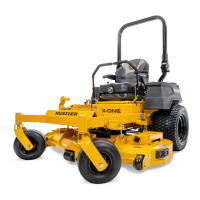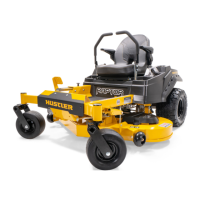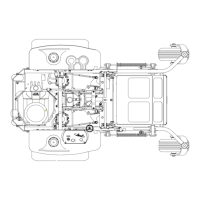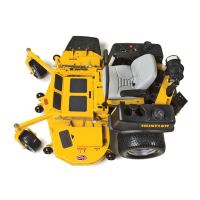REV D 3-6 604466
interlock system section.
7. As soon
as the engine begins to run, check to make
certain the oil warning light is off. If not, stop the engine
immediately and check for the cause.
8. All
ow the engine to idle a few minutes before advancing
the throttle and/or engaging the deck clutch.
Stopping The Engine
Use the following procedure to shut off the engine after
operating the equipment.
1. Place the steering control levers in the park brake
posit
ion.
2. Throttle the
engine back to low idle, then disengage the
deck clutch. Refer to Mower deck operation section for
more details.
3. Let
the engine run at low idle for a couple of minutes.
4. Ro
tate the ignition key counter-clockwise to the “OFF”
position. Remove the key from switch before leaving the
mower.
Moving The Mower With Stalled Engine
If it becomes necessary to move the mower when the engine
is inoperative, the integrated transmissions are equipped with
bypass valves. Figure 3-5 & Figure 3-6
Before moving the unit, turn bypass valve levers clockwise
until the
stop is engaged. The valve lever on each hydraulic
pump is located at the front of the transmission. Figure 3-5 &
Figure 3-6
The steering control levers must be placed in the neutral
position, to relea
se the park brakes, so that the mower can be
moved.
Do not tow the machine. Move it by hand or use a winch to
load
on a trailer for transporting.
When transporting on another vehicle, the mower should be
facin
g forward and it must be secured.
IMPORTANT: Alw
ays make certain the two bypass valves
are returned to their operating position before running the
mower following repairs.
ROPS (Roll Over Protective Structure)
A ROPS may minimize the chance of injury or death from
rollover.
A ROPS, when used with a seat belt, is
effective in reducing
injuries during unit overturn accidents. Overturning the unit
without a ROPS or without ROPS locked in the raised position
can result in serious injury or death. Figure 3-7
The two-post ROPS can be pivoted down by removing the
ri
ght and left retaining rings (Figure 3-7), and pulling out on the
clevis pins so that the machine can operate
under low hanging
tree limbs or other obstructions. Do not wear the seat belt when
the ROPS is in the lowered position. Use the ROPS in the
Figure 3-5
Figure 3-6
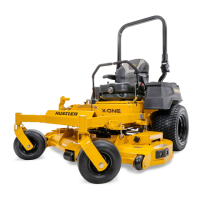
